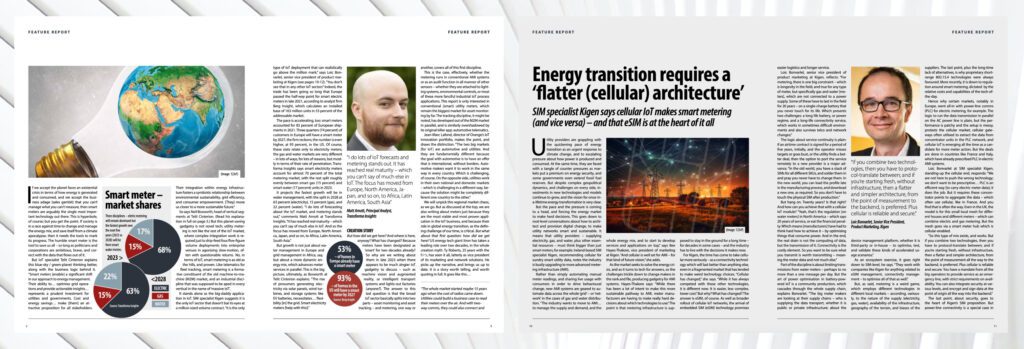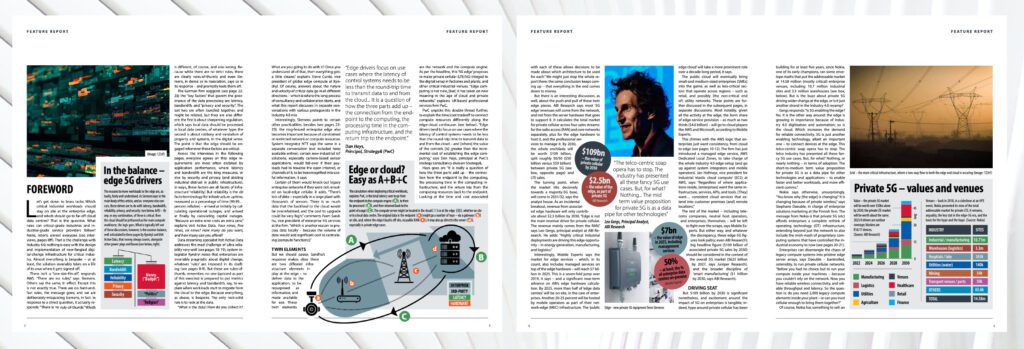Some new-year reading, before the 2024 news agenda goes into over-drive; here, the enterprise team at RCR Wireless picks some choice long-form reports from 2023 about all-things IoT (low- and high-power, and in between) to set the conversation for 2024-in-tech. Enjoy.
1 | Smart meters – why meters matter, and how IoT is driving the energy transition (Dec 2023)

Excerpt |
If we accept the planet faces an existential crisis in terms of how energy is generated and consumed, and we accept the business adage (sales gambit) that you can’t manage what you can’t measure, then smart meters are arguably the single most important technology out there. This is hyperbole, of course; but you get the point. If society is in a race against time to change and manage the energy mix, and save itself from a climate apocalypse, then it needs the tools to mark its progress. The humble smart meter is the tool to save us all – so long as politicians and corporations are ambitious, brave, and correct with the data that flows out of it…
All of which tells us just about everything we need to know about this business: its original function, to provide remote access and control; the hot mess of (non-cellular) tech that has grown up in its wake; the luck of electric metering, to have a ready power supply; the challenges with gas and water metering, to trade power and performance on battery-powered units, plus the lack of infrastructure to host private IoT networks; the slow change and critical nature of the utility market; and the late rise of low-power cellular IoT as a well-made connectivity and ready-made network solution for all differ- ent metering disciplines. It is all here; we just need to pick through it a piece at a time…
Quotes |
“I do lots of IoT forecasts and metering stands out. It has reached real maturity – which you can’t say of much else in IoT. The focus has moved from Europe, North America, Japan, and so on, to Africa, Latin America, South Asia” – Matt Arnott, Principal Analyst, Transforma Insights
“If you combine two technologies, then you have to protocol-translate between; and if you’re starting fresh, without infrastructure, then a flatter and simpler architecture, from the point of measurement to the backend, is preferred. Plus, cellular is reliable and secure.” – Loic Bonvarlet, Senior Vice President, Product Marketing, Kigen
“You can’t ask for 100 percent on one SLA and 100 percent of one technology. If you want 100 percent cellular, then the performance you get is what you get. So you say: deliver me 98 percent on this SLA, and fire the provider that fails. Or you say: give me PLC or Wi-SUN. But you can’t ask for both.” – Fabien Pettitgrand, Chief Technology Officer, Ubiik
2 | Industrial 5G Forum – key findings report (Dec 2023)
Excerpt |
Has 5G failed? No. Except you’d be forgiven for thinking so given everything that has been written about it in recent months – at least among the things we read, by the people we rate (and you all read, too). It’s like the critics have seen enough, and decided, one after another, to pause the play and deliver their half-time analysis. And the verdict ain’t pretty: 5G, five years old already, has failed to deliver the industry turnaround that all the research and money – and all the big talk and hard work – was for. And so the 5G backlash is in full swing.
The defenders are lame, the attackers are lost, and the manager is crook. And the crowds haven’t turned up. The commentary says this team is headed for a beating; that telecoms is dead. The market over-promised and under-delivered. And probably this is right; these pundits know their corporate bloodsport. But it is not half time; it’s mid-season with plenty to play for. And… [theirs] is a telco-centric view… [and] 5G cannot be judged – from the point of view of its relevance, application, or success – only from a telco-centric position.
Quotes |
“There is a disconnect between current software engineering practice, which almost fetishizes change all the time, versus what a lot of people in industry want, which is to change nothing-ever once it is deployed… We are now playing in the real world with real machines – not virtual ones. And that requires a degree of discipline that I’m not sure the software industry has had before.” – David Rolfe, Head of Product Marketing, Volt Active Data
“In process [manufacturing]…you have to imagine my factories are big kitchens. You have big tanks, you have materials coming in, we cook them, we cool them down. Everything is static…It’s difficult to imagine some [5G] use cases there in the short term.” – Alexis Kydonopolous, Site Director, Cargill
“If we look at the market in general right now, the wheel is not really that round. It’s like the market’s not really ready to roll forward because in many applications, the business model is not quite there or maybe the devices aren’t ready for 5G.” – Joe Madden, Founder and President, Mobile Experts
3 | 5G-enabled IoT – will RedCap deliver on the promise of digital transformation? (Dec 2023)
Excerpt |
Despite the speed of its growth, 5G arguably has not yet been a broad-based enabler of digital transformation in the sense of establishing and supporting a fully connected world, particularly when it comes to the internet of things and the new revenue streams that carriers have been hoping for. The initial focus of 5G has been on the enhanced mobile broadband (eMBB) use case, mostly serving wireless consumers with increasingly expensive smartphones, with flagship models that can run more than $1,000. The dearth of 5G-enabled modules and diverse and new connected devices, at affordable price points that would enable large scale, has hindered the achievement of a vision of 5G as one technology to rule them all.
But 5G is poised to enter a new phase, with the emergence of 5G New Radio Reduced Capability (RedCap) aimed at bringing mid-tier 5G capability, along with lower costs and better power efficiency, to the maturing 5G ecosystem. RedCap is seen as the natural next step, the evolution for most mid-tier IoT broadband devices to proceed along the 5G path. But walking a middle path to 5G may end up being the long road, especially when RedCap will, for the foreseeable future, directly compete with both Wi-Fi and LTE doing their respective jobs admirably. RedCap is seen as the inevitable future for 5G IoT, but how fast that future becomes reality is still uncertain.
Quotes |
“We solved a lot of the mobile broadband, or eMBB, part of the 5G story. Now the question is, how we onboard billions of devices in different sizes and different characteristics, et cetera. RedCap is going to help us with this.” – Igal Elbaz, Network CTO, AT&T
“[RedCap is] inevitable, because there is still a big gap between what the top tier 5G performance is, as well as the cost perspective.” – Neil Shah, Co-Founder and Research Director, Counterpoint Research
“People want 5G, but they don’t want a device or a module … for a hundred dollars a chip. The economics just don’t make sense. So that’s where RedCap comes in.” – David Lieber, Head of Sales, North America, Fibocom
4 | Critical 5G edge workloads – what stays, and what goes? (Oct 2023)

Excerpt |
Let’s get down to brass tacks. Which critical industrial workloads should stay on site at the enterprise edge, and which should go to far-off cloud data centres? That is the question. What rules should critical-grade industries and industrial-grade service providers follow? None, retorts almost everyone. That is the challenge with Industry 4.0; nothing is easy with the design and implementation of new-fangled digital-change infrastructure for critical industry. Almost everything is bespoke – and the solution invariably takes on a life of its own when it gets to sign-off…
Everyone agrees on this: edge requirements are most often dictated by application performance, where latency and bandwidth are the king measures, or else by security and privacy. In ways, these factors are all facets of infrastructure ‘reliability’. But reliability is the de facto terminology for infrastructure uptime, measured as a percentage of time (99.99… percent reliable) – arrived at by calculating operational and capital outages. And every extra nine costs an extra zero. So, four nines, five nines, six nines – how many do you want, and how many can you afford?…
Quotes |
“The telco-centric soap opera has to stop.The industry has presented all these fancy 5G use cases. But, for what? Nothing… The mid-term value proposition for private 5G is as a data pipe for other technologies” – Leo Gergs, Principal Analyst, ABI Research
“[Vendor supply is about] politics, religion, and budget… You’ve got to know where the money is, where the power is, and where the bias is. That last one – religion or culture, or bias – is important, too. If the customer is a Cisco-shop, then will they be mad at you for coming with something else? It is the same in telecoms; some operators are all-in on Ericsson, say; so if you go with Nokia or Samsung, they might ask what you think you’re doing.” – Steve Currie, Distinguished Engineer, VP of Global Edge Compute, Kyndryl
“Before you had no choice but to run your compute in your machines – because you couldn’t rely on the network. Now you have reliable wireless connectivity… So the question is: do you need 2,000 legacy compute elements inside your machines inside your plant?” – Stephane Daeuble, Head of Enterprise Solutions Marketing, Nokia
5 | Private Networks Forum (Global) – key findings report (Sep 2023)
Excerpt |
What tangible progress has been made since spectrum started to be liberalised for private enterprise usage in leading markets, and the supply chain started to limber up? The answer, on the face of it, is: not a whole lot. The same issues with availability of devices, spectrum, and features still generally apply; the same tangles with use cases, business cases, and scalability remain mostly unresolved. The supply side and demand side are still struggling, to an extent, to speak the same language; certainly the challenge to identify clear use-case driven returns is a sticking point, in all but-a-few scenarios – particularly indoors, and particularly in factories…
There is frustration that the market is not moving faster – to the point there is a blame-game, of sorts; that there aren’t enough devices, because there aren’t enough chipsets. But this stuff takes time; and maybe, actually, progress is pretty okay… [And] the blame-game is wrong… There aren’t enough chips because there isn’t enough demand… And the demand is not there because the technology is not there – at least for the big industrial engine room at the heart of this broader economic transformation.
Quotes |
“Factories are becoming more dynamic. In the past, you designed a factory to stay the same for 10 or 20 years. But we now change the factory every couple of months to increase capacity or introduce new products, and there are new digitalisation projects every day. Which increases the demand for reliable coverage… [All the] open space and metalwork [makes] it challenging for Wi-Fi… which is why we started with 5G [in the first place].” – Utku Barış Pazar, Chief Strategy and Digital Officer, Arçelik
“There is this question about what to do when an asset leaves or enters a facility. At the moment, there are two different use cases: inbound roaming, such as with a campus or stadium, where users enter onto a private network, which requires collaboration between the micro and macro network; and outbound roaming, which is linked with eSIM capabilities, and which is where we want to orchestrate connectivity between private and public 5G.” – Richie Gill, Director of Product Management, KORE
“Private 5G changes everything because it’s unique and specific to different industry verticals. The ecosystem may be different in certain manufacturing elements to other industries. It’s changing the whole dynamic. It’s no longer a one-size-fits-all. It is about the telco industry adapting and integrating with some of its verticalized customers.” – Gary Baker, Head of International Private 5G Networks, Verizon
6 | Private 5G for IoT – plotting timelines, defining applications, making bets (Jul 2023)
Excerpt |
5G covers more ground than we know, and 5G does not go as far as we think. In other words, a neat and easy discussion about its likely timelines, applications, and successes is impossible. Much of this report focuses on an industrialised version of 5G, but 5G will find purchase across a great swathe of economic disciplines. The argument goes that the market is too-obsessed with a future where the kings of industry, like Volkswagen, animate their production lines using Release 18-level URLLC 5G networks…
Part of the trouble with this vision is it is so intoxicating; the mobile industry has got high on its own Kool-Aid, and painted multi-sided industrial change in primary colours… There is disillusionment that it has not happened any faster. “The problem was not all of this was communicated to implementers.” Is that the fault of the telecoms community? “Yes.”… Right, so what about this dream of industrial revolution? When does the market deliver high-end automation and lights-out factories? Does that take a decade? “A decade, at least.”
Quotes |
“If we need to roll out a new site, we know exactly [what to do] – we have a template, already. We go there, do some radio studies, and it is deployed. It takes a few weeks. With regards to use cases, 80 percent of our sites use the same digital tools… We still have specifics [at each site] that require closer vertical integration. But really, that is the fun part.” – Hakim Achouri, 5G and IoT Expert, Digital Aviation, Airbus
“Why should I have to defend that (the timing of Siemens’ entry to the private 5G market)? You heard Volkswagen, on stage with me; it said, three years before it gets mainstream in its factories. Airbus said the same: three years. Everyone thinks it will be mainstream three years from now. So why do something quicker, just to be early?” – Sander Rotmensen, (former) Head of Product Management for Industrial Wireless, Siemens
“You have large hyperscalers with a hundred million accounts now; they have captured a lot of the IT budget… People have not realised what has happened over the years. They are in every boardroom. They can say, ‘I want to speak to the CEO of industry-company X’, and they’ll have an appointment within a week.” – Bernd Gross, Chief Technology Officer, Software AG
7 | IoT in the supply chain – how IoT grew up and got real, in the hardest sector of them all (Jan 2023)
Excerpt |
The supply-chain industry is big and rangy, and hard to pin down. The global logistics market was worth $8.4 trillion in 2021, and is forecast to be worth $10.4 trillion by the end of 2022 and $13.7 trillion by 2027 – growing at around 24 percent in 12 months and 30 percent over five years. Most of it goes on the road – over 50 percent is on ground freight. But the global market is required to navigate railways, water-ways, and air-ways, as well – and run in and out of factories, ports, ware- houses, and other points between.
There are deep pockets and deep silos to complicate matters for any blue-eyed tech vendor promising to remake a market that goes back thousands of years. [Because] logistics is arguably the hardest Industry 4.0 sector of them all… [and] the transformative potential of such a complex web of commerce would be revelatory if it could be untangled by technology. New digital pyrotechnics (IoT and AI, in all their forms) look more and more like they are up to the task. The global logistics market might be starting behind the rest of the Industry 4.0 pack, nestled in their own easy closed-loop venues, but it could yet have the most explosive finish…
Quotes |
“We have seen how technology has revolutionised industries, but it won’t be the same in logistics. It is the most embedded vertical in the world – there is nothing like it. Innovation will be, and has to be, gradual in logistics.” – Erich Hugo, Managing Director of Business Innovation, DeltaTrak
“Logistics is the worst for data silos… The supply chain is collaborative – because it is a chain. But it has lost track of that. If companies want to change, then they have to col- laborate – and visibility data is the best way to do that.” – Bart de Muynck, Chief Information Officer, project44
“These are all these huge data repositories, which further reveal what’s happening in a supply chain. They have a lot to say, if they’re allowed to talk to each other. But they are not being connected – which is one of the big problems, and one of the big opportunities.” – Tancred Taylor, Industry Analyst, ABI Research
Links | report; webinar

